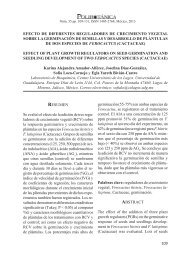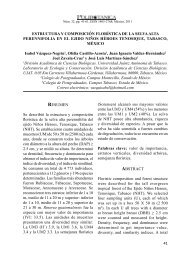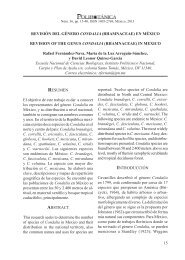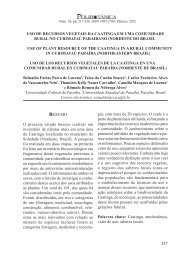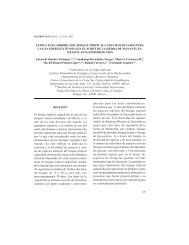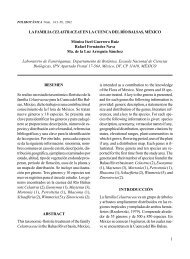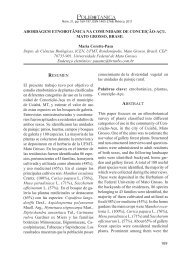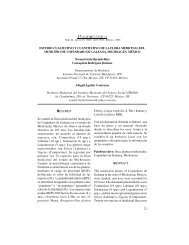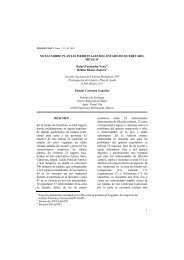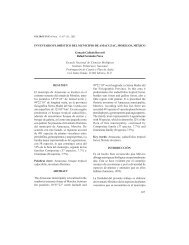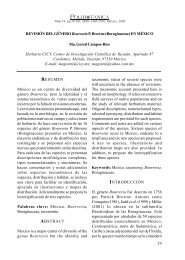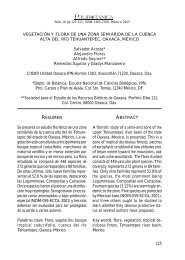Plantas vasculares endémicas de la Cuenca del rÃo ... - Polibotánica
Plantas vasculares endémicas de la Cuenca del rÃo ... - Polibotánica
Plantas vasculares endémicas de la Cuenca del rÃo ... - Polibotánica
You also want an ePaper? Increase the reach of your titles
YUMPU automatically turns print PDFs into web optimized ePapers that Google loves.
RESULTADOS Y DISCUSIÓN<br />
Núm. 20:73-99<br />
CONCLUSIONES<br />
Diciembre 2005<br />
De <strong>la</strong>s especies registradas a <strong>la</strong> fecha en<br />
dicha zona <strong>de</strong> estudio, 337 se encuentran<br />
en <strong>la</strong> categoria <strong>de</strong> endémicas (listado<br />
anexo). Por lo que se refiere a <strong>la</strong>s pteridofitas<br />
se <strong>de</strong>tectaron 14 taxones pertenecientes a <strong>la</strong>s<br />
familias Aspleniaceae (1), Polypodiaceae (1),<br />
Pteridaceae (7), Schizaeaceae (1),<br />
Se<strong>la</strong>ginel<strong>la</strong>ceae (1), Thelypteridaceae (1) y<br />
Woodsiaceae (2) (fig. 2). En <strong>la</strong>s dicotiledóneas<br />
se registran 37 familias, <strong>la</strong>s mejor<br />
representadas son <strong>la</strong>s compuestas con 48<br />
taxones, leguminosas con 30, cactáceas con<br />
21 y los «copales» (Burseraceae) al igual<br />
que <strong>la</strong>s crasuláceas agrupan 17;<br />
Euphorbiaceae con 14, otras fami<strong>la</strong>s como<br />
Malvaceae y Rubiaceae <strong>de</strong>stacan también<br />
por el número <strong>de</strong> especies, con 10 cada una<br />
<strong>de</strong> el<strong>la</strong>s (fig. 3). De <strong>la</strong>s nueve familias<br />
que componen el grupo <strong>de</strong> <strong>la</strong>s<br />
monocotiledóneas, <strong>la</strong>s orquí<strong>de</strong>as,<br />
bromelias y liliáceas reúnen el mayor<br />
número, <strong>la</strong> primera 24 y <strong>la</strong>s otras dos<br />
16 cada una (fig. 4).<br />
En re<strong>la</strong>ción a los estados, Guerrero ocupa el<br />
primer lugar en en<strong>de</strong>mismo con 82 especies<br />
exclusivas <strong>de</strong>l total registrado, le sigue el<br />
estado <strong>de</strong> México con 47, Michoacán 44,<br />
Morelos 25, Oaxaca 17, mientras que en<br />
Pueb<strong>la</strong> y Jalisco se registran 8 y 7<br />
respectivamente (fig. 5).<br />
Por lo que se refiere a <strong>la</strong> ubicación ecológica,<br />
el 37% (128 spp) <strong>de</strong> lo registrado<br />
actualmente es exclusivo <strong>de</strong>l bosque tropical<br />
caducifolio, 14% (46 spp) prosperan en el<br />
matorral xerófilo, 12% (40 spp) en el bosque<br />
<strong>de</strong> encino, 10% (33 spp) en el bosque <strong>de</strong><br />
pino-encino y el 27% (90 spp) restante se<br />
distribuye entre el bosque mesófilo, el<br />
bosque espinoso, pastizal y <strong>la</strong> vegetación<br />
secundaria (fig. 6).<br />
76<br />
De manera preliminar y sin consi<strong>de</strong>rar<br />
completo este inventario, el en<strong>de</strong>mismo<br />
específico en <strong>la</strong> cuenca <strong>de</strong>l río Balsas<br />
representa el 7.6 % con re<strong>la</strong>ción al listado<br />
florístico e<strong>la</strong>borado por Fernán<strong>de</strong>z et al.<br />
(1998). El número <strong>de</strong> pteridofitas endémicas<br />
es significativo, ligeramente superior al <strong>de</strong><br />
algunas monocotiledóneas como<br />
Dioscoreaceae (13 spp) y Gramineae (11 spp)<br />
que también <strong>de</strong>stacan por su<br />
representatividad. Algunos taxones que en<br />
el pasado fueron consi<strong>de</strong>rados endémicos<br />
<strong>de</strong> <strong>la</strong> porción oaxaqueña, el caso <strong>de</strong><br />
Cheiloplecton rigidum (Sw.) Fee var.<br />
<strong>la</strong>nceo<strong>la</strong>tum C. Hall ex Mickel & Beitel o<br />
Polystichum smithii Mickel & Beitel<br />
(Arreguín, 2000; Fernán<strong>de</strong>z et al., 2000), han<br />
<strong>de</strong>jado <strong>de</strong> tener esta categoría al ampliar su<br />
área <strong>de</strong> distribución, producto <strong>de</strong> <strong>la</strong>s<br />
colectas recientes o revisiones en otras<br />
entida<strong>de</strong>s <strong>de</strong> <strong>la</strong> República Mexicana y <strong>de</strong><br />
Mesoamérica (Arreguín et al., 2000; Lorea<br />
y Velázquez, 1998; Mickel y Smith, 2004;<br />
Moran y Riba, 1995; So<strong>la</strong>no, 1997; Tejero,<br />
1998; Torres y Tejero, 1998; Zepeda y<br />
Velázquez, 1999). Algo simi<strong>la</strong>r se presenta<br />
con Astragalus cenorrhynchus Barneby<br />
y Robinsonel<strong>la</strong> chiangii Fryxell,<br />
consi<strong>de</strong>radas endémicas en <strong>la</strong> provincia<br />
florística <strong>de</strong>l valle <strong>de</strong> Tehuacán-Cuicatlán<br />
(Mén<strong>de</strong>z et al., 2004) y en este trabajo <strong>de</strong> <strong>la</strong><br />
cuenca <strong>de</strong>l Balsas, situación que valdría<br />
<strong>la</strong> pena reconsi<strong>de</strong>rar con el fin <strong>de</strong> conocer<br />
los límites <strong>de</strong> distribución <strong>de</strong> <strong>la</strong>s mismas.<br />
La riqueza florística <strong>de</strong> <strong>la</strong>s compuestas,<br />
leguminosas y orquí<strong>de</strong>as se ha manifestado<br />
con anterioridad por diversos autores en el<br />
área <strong>de</strong> estudio (Espejo et al., 2002; Jiménez<br />
et al., 2003; Sousa y Delgado, 1993;<br />
Vil<strong>la</strong>señor, 1987); en este trabajo <strong>la</strong>s tres<br />
familias mencionadas representan el 2.5%




